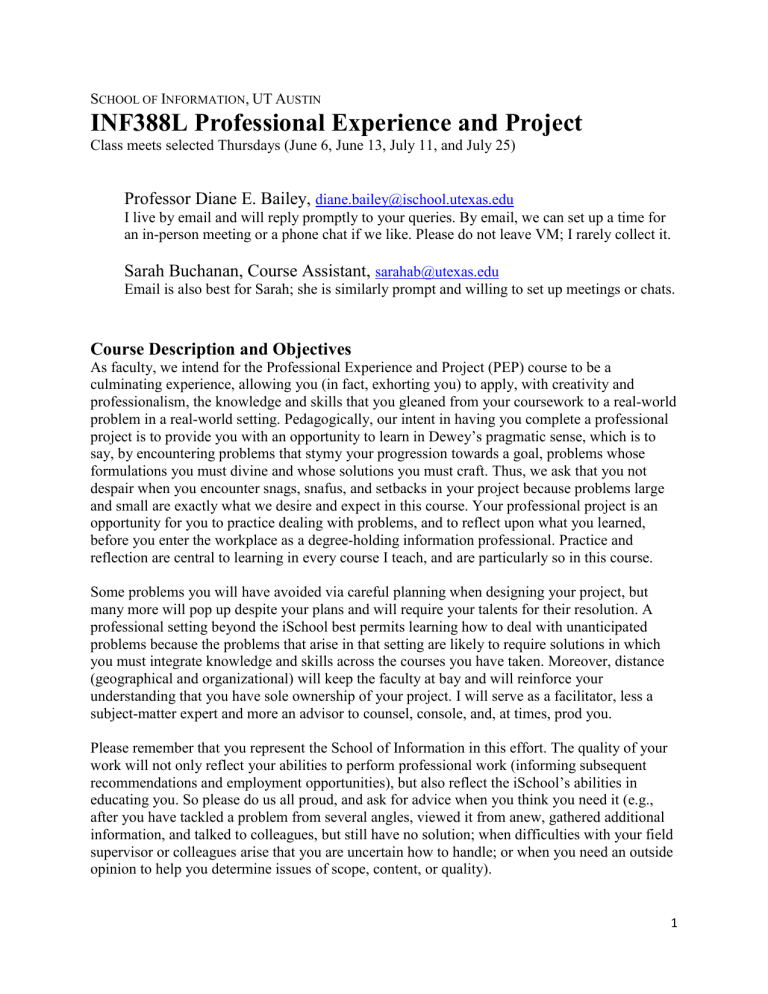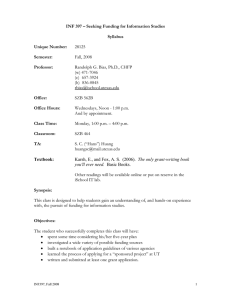INF388L Professional Experience and Project ,

S CHOOL OF I NFORMATION , UT A USTIN
INF388L Professional Experience and Project
Class meets selected Thursdays (June 6, June 13, July 11, and July 25)
Professor Diane E. Bailey,
diane.bailey@ischool.utexas.edu
I live by email and will reply promptly to your queries. By email, we can set up a time for an in-person meeting or a phone chat if we like. Please do not leave VM; I rarely collect it.
Sarah Buchanan, Course Assistant,
sarahab@utexas.edu
Email is also best for Sarah; she is similarly prompt and willing to set up meetings or chats.
Course Description and Objectives
As faculty, we intend for the Professional Experience and Project (PEP) course to be a culminating experience, allowing you (in fact, exhorting you) to apply, with creativity and professionalism, the knowledge and skills that you gleaned from your coursework to a real-world problem in a real-world setting. Pedagogically, our intent in having you complete a professional project is to provide you with an opportunity to learn in Dewey’s pragmatic sense, which is to say, by encountering problems that stymy your progression towards a goal, problems whose formulations you must divine and whose solutions you must craft. Thus, we ask that you not despair when you encounter snags, snafus, and setbacks in your project because problems large and small are exactly what we desire and expect in this course. Your professional project is an opportunity for you to practice dealing with problems, and to reflect upon what you learned, before you enter the workplace as a degree-holding information professional. Practice and reflection are central to learning in every course I teach, and are particularly so in this course.
Some problems you will have avoided via careful planning when designing your project, but many more will pop up despite your plans and will require your talents for their resolution. A professional setting beyond the iSchool best permits learning how to deal with unanticipated problems because the problems that arise in that setting are likely to require solutions in which you must integrate knowledge and skills across the courses you have taken. Moreover, distance
(geographical and organizational) will keep the faculty at bay and will reinforce your understanding that you have sole ownership of your project. I will serve as a facilitator, less a subject-matter expert and more an advisor to counsel, console, and, at times, prod you.
Please remember that you represent the School of Information in this effort. The quality of your work will not only reflect your abilities to perform professional work (informing subsequent recommendations and employment opportunities), but also reflect the iSchool’s abilities in educating you. So please do us all proud, and ask for advice when you think you need it (e.g., after you have tackled a problem from several angles, viewed it from anew, gathered additional information, and talked to colleagues, but still have no solution; when difficulties with your field supervisor or colleagues arise that you are uncertain how to handle; or when you need an outside opinion to help you determine issues of scope, content, or quality).
1
In many ways, the PEP course is an opportunity for you to hone your presentation of your professional self by highlighting your strengths, demonstrating your knowledge and skills, and providing firsthand evidence of your ability to work with others in a professional setting. To help in this endeavor, the course will meet four times. Twice – the first session and the last session – you and your peers will present your work. In watching your peers speak, you will witness the breadth of interests in the iSchool and observe a variety of project presentation techniques, with a chance to apply techniques that you like in your future talks. In speaking before your peers, you will have a chance to practice explaining the work you do and how you think about that work.
This kind of reflection should refine your own understanding of why your work is interesting and important. In between these two speaking sessions, a Purple Shirt will hold a session to cover technical details of how to present yourself in a digital setting (i.e., how to create your eportfolio). In another session, Tara Iagulli and I will help you with some of the social, cultural, political, organizational, and personal aspects of how to present your professional self via talks, your résumé, your e-portfolio, social media, networking events, or other professional venues.
Learning Outcomes
Via practice, reflection, and presentation in this course, you will gain knowledge and skills in
Preparing and revising a proposal for work in project form
Negotiating (perhaps more than once) expectations and deliverables with a supervisor
Conducting independent work, including making, meeting, and possibly adjusting internal deadlines and schedules to meet a firm external deadline
Understanding and resolving unanticipated problems
Presenting completed work, including its objective and importance
Presenting your professional self through a variety of media and venues
Course Schedule
Date
June 6 th
June 13 th
June 27 th
Creating an E-portfolio (Purple Shirt)
- No Class -
Learning journal entry (1
Learning journal entry (2 st
) nd
)
July 3 rd
July 11 th
Class Topic
Introduction of Projects (Students)
- No Class -
Presenting Your Professional Self
Due (assignment info begins on next page)
Poster abstract (note this is a Wednesday)
E-portfolio; Learning journal entry (3 rd
)
(Tara Iagulli and Diane Bailey)
July 25 th
Poster Session (Students) Poster; Field supervisor's evaluation form;
E-portfolio revision if required
Grading
Grading is CR/NC, based on completion of the following five items:
1.
Professional project, as verified by field supervisor (this component signifies the
PRACTICE part of learning)
2.
Learning Journal (this component signifies the REFLECTION part of learning)
3.
E-portfolio (this component signifies the PRESENTATION of self)
4.
Abstract and Poster (this component signifies the PRESENTATION of work)
5.
Class Attendance
2
Professional Project
You should devote approximately 120 hours on your project up to July 25 th
, the last day of class.
You have already submitted, and I have approved, in some cases subject to revision, your project proposal. Please notify me if your project changes in scope or content over the course of this summer term. On July 25 th
, you must submit to me your field supervisor’s completed evaluation form. I will provide a link to the form, a digital copy of the form, or the physical form in class.
Learning Journal
You should submit to me electronically (as pdfs) three learning journal entries on these dates:
June 13 th
, June 27 th
, and July 11 th
. Each entry should contain a personal exploration of what you are learning about yourself in the professional setting of your project. What problems arose and how did you handle them? How satisfied are you with how you handled them? What seemed to work well and what worked less well? Why did the problems arise? What might you have done to circumvent them? Include technical (e.g., the servers crashed, the code failed, the software never came), social (e.g., your field supervisor berates you, you are tongue-tied in meetings), organizational (e.g., you have no authority to get the information you need, no one helps you because no one will get credit for helping you), and other problems. The point of the entry is not to malign the technical infrastructure, your supervisor and colleagues, the organization, or you; rather, the point is to force you to take a step back and think about how you are interacting in this setting. If no problems came up since your last entry and everything is going just fine, reflect on why that is so, or address near misses. I expect more than a paragraph for each entry, but not reams; a couple pages seem about right, and more are welcome.
Electronic Portfolio (E-Portfolio)
An e-portfolio is a Web site that you create that displays your professional interests, aims, and pursuits. The purpose of an e-portfolio is to help you prepare for your ideal professional job upon graduation and to help future employers understand who you are and what you want. Your eportfolio is a means of presenting your professional self by sharing your aspirations, résumé, education, and samples of work (projects, papers, Web sites, and so forth).
To receive credit for INF 181E Electronic Portfolio, the companion course to this course that is also required for graduation under the new core, you must include the following items at a minimum on your e-portfolio:
Statement of intent.
In 400 words or less, detail your professional goals. Discuss how your iSchool education, your undergraduate degree, your volunteer efforts, prior employment, and/or similar events and experiences reflect and helped shape your professional interests and how they will aid you in achieving your goals. Think of the intended audience as a recruiter, hiring manager, or potential employer. Articulate your goals at a high level to demonstrate how your skills might translate to multiple environments. For example, the same skills that enable success as a reference librarian in a public library—ability to refine research questions, identify appropriate sources, and determine strategies for evaluating the value of retrieved materials—also enable success in domains such as market research, competitive intelligence, and so on. Similarly, the same skills that enable success as a library cataloger are equally good preparation for roles in digital asset management.
3
Working links to samples of at least three papers or projects that you completed for iSchool courses or as independent projects. Include brief descriptions of each one (a sentence or two should be fine) so that the viewer understands: o What the sample is. o The knowledge, skills, or perspective that the sample demonstrates. o If appropriate, why the sample is important to your professional identity.
Your résumé.
For tips on building a top-notch résumé, look for the Resource Guide in the
Resource Library at iCareers: https://www.ischool.utexas.edu/careers/students . Typically, a résumé summarizes: o Contact information. o o
Education.
Previous work experience. Summarize key functions and accomplishments that are relevant to your current goals. o o
Skills not apparent from the work experience or education information (for example, languages spoken, including both human and computer).
Awards and honors if they are relevant to your professional goals.
When you have completed your portfolio, send an e-mail with the portfolio URL to me no later than July 11 th
. If the portfolio is satisfactory, then I will notify you and you are done. If the portfolio is not satisfactory, then I will notify you of what you need to do to improve it; the revised e-portfolio will be due July 25 th
and must be sufficient by that date for course credit.
Abstract and Poster
By Wednesday, July 3 rd
, you must send an abstract for your poster to Sarah, our CA, via email.
The abstract must include this information, neatly labeled as such:
Your name
Project title
Host organization
Field supervisor’s name
Abstract (approximately 150 words, less is fine)
You will also need to create a poster for presentation at our poster session. For information and useful advice on how to prepare your posters, and how to design good ones, go to https://www.ischool.utexas.edu/programs/masters/capstone/poster_session_guidelines .
The poster session will be held from 3-4 p.m. on July 25 th at the iSchool.
Class Attendance
All four sessions in their entirety are mandatory except the e-portfolio session, which you may miss if you (a) notify me by email by June 10 th
, and (b) provide a URL link to a working, perhaps incomplete, e-portfolio as evidence of your ample technical web skills. If you are doing a project far outside Austin, please remind me by email that you will miss some or all class sessions.
4

